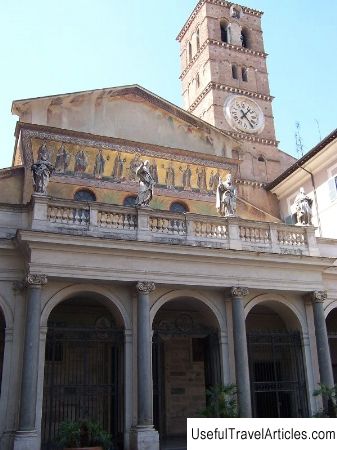Basilica of Santa Prassede in Italy, Rome resort
Rating: 7,8/10 (120 votes)  The Basilica of Santa Prassede is a Roman titular church dedicated to Saint Praskeva. The basilica is located on the Esquiline hill near the Basilica of Santa Maria Maggiore. The cycle of mosaics of the presbytery and the unique chapel of St. Zeno was created in the basilica by Greek monks who fled from Byzantine iconoclasm, and found shelter at Paschal I . One of the main attractions of the church is the pillar – one of the instruments of the Passion of Christ, to which Christ was tied during the scourging. According to legend, the first baptistery was built on this place by Saint Praskeda on the estate inherited by her from father, sister and brother. Here the saint sheltered persecuted Christians, and also collected the bodies of the martyrs, which she buried in the catacombs of Priscilla. The basilica that exists in our time was erected by Pope Paschal I in 817 and, in general, managed to preserve its original appearance. The construction of the building was carried out in the image of the original St. Peter's Cathedral. At the end of the construction, Paschal the First ordered to transfer the relics of the martyrs from the catacombs to the basilica. Pope Paschal the First attracted many Greek monks to Rome – icon-worshipers who fled from the second wave of iconoclasm in Byzantium. During this period, many Roman churches were decorated with mosaics, and the image of the pope was immortalized in the temples of Santa Maria in Domnica. Santa Cechelia in Trastevere and Santa Prassede. In 1223, a 'scourging column' appeared in the church, to which Christ was tied in the praetorian court during the scourging. Such a significant shrine immediately raised the status of the church – it served as a liturgy every fourth Sunday during Great Lent. Until the end of the 15th century, the presbytery was connected to the Chapel of the Crucifixion and Campanile by means of arches decorated with columns. At the turn of XV – In the 16th century, the arches were closed with blank walls by order of the titular cardinal of the basilica, Antonio Pallavicini. On the upper level, a choir was set up, which was intended for monks who had the right to participate in worship. In 1564-1584, the basilica underwent a large-scale reconstruction, led by Carlo Borromeo. In the course of the work, the presbytery was enlarged at the expense of the main nave. The mosaic located in the lower part of the triumphal arch was partially destroyed, in its place appeared small balconies for displaying relics. In 1594-1600, Allesandro Medici was ordered to decorate the wall space above the columns. And today you can see eight frescoes depicting episodes of the Passion of Christ. In the 20th century, a number of reconstruction works were carried out, during which the building of the basilica, in terms of architecture, was close to the original. The main nave had baroque layering, plaster was knocked off the facade, and the floor was covered with marble slabs. We also recommend reading Capitoline Square in Italy, Rome resort Topic: Basilica of Santa Prassede in Italy, Rome resort. |




